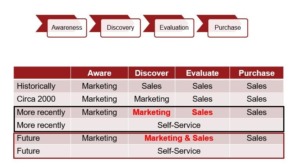The conversation about aligning marketing and sales began over a decade ago.1 After ten years, less than 50% of organizations surveyed said they aligned appropriately to achieve the financial results for which they are accountable.
The resistance persists because achieving the synergies between marketing and sales is not viewed as transformational. It does not get the top-down executive support it requires. Nor does it get the governance structure that major transformation initiatives require to succeed.
There was a point in time when alignment between the two organizations made perfect sense. In today’s digital world where buyers prefer digital self-service (Figure 1) and remote human engagement, it is no longer the right way to think about the relationship between marketing and sales.
Figure 1
Alignment is necessary but not sufficient for a buyer’s journey that is no longer linear. Nor is alignment alone appropriate given the technology that exists today to drive workflow and collaboration between marketing and sales.
Collaboration, along with alignment, is the key to a successful partnership between marketing and sales. Collaboration goes beyond the funnel to a working partnership that starts with planning and ends with measuring performance. The closer the collaboration between the functions, the faster the business will grow.
#BeyondAlignment is the next generation of interaction that occurs between marketing and sales in a digital self-service world shaped by buyers’ preferences.
But before we can begin to talk about the interaction between marketing and sales, we need to talk about each organization’s fundamental roles:
- Marketing creates brand awareness and generates interest for products and services
- Sales closes opportunities that result from marketing’s efforts.
These are mutually exclusive. However, the goals the two teams have in common provide a broader basis for this discussion. The two teams:
- Are incented for profitable growth through acquisition and retention
- Reinforce and protect the brand
- Have the opportunity to build long term lasting relationships with customers
- Both receive customer feedback to contribute to a real time feedback loop
- Both will nurture the customer towards a closed transaction.
Continuing to work in silos and handing off a Marketing Qualified Lead has not been effective and will continue to be ineffective.
THE (R)Evolution
Until now, words like
- Communication
- Trust
- Mutual respect
- Teamwork
- Common vocabulary (a more recent addition)
have been used to describe the ideal relationship between marketing and sales. These attributes are necessary but not sufficient to get us closer to a more powerful model. The foundation for these collaborative processes should include:
- Buyers’ preferences
- Executive sponsorship
- A closed loop feedback and communication environment
- A culture of inclusion
- A common vocabulary
- Common or tightly integrated marketing and sales technical platforms
- A shared data environment that is the single source of truth of customers
- Plus all of the attributes we aspired to in the alignment model
- Trust
- Mutual respect
- Teamwork
Collaboration breeds efficiency, more effective distribution of work and higher quality decisions and outputs. Collaboration is an indication of a healthy work environment where trust and inclusion are inherent cultural norms. Therein lies the transformational aspect of #BeyondAlignment.
ALIGNMENT VS. COLLABORATION
Alignment is an “arrangement in a straight line or in correct or appropriate relative positions”. The very term connotes rigidity. Progress is regimented and predictable. The flow contains a “handoff” from marketing to sales at a predetermined event (i.e. a lead score reaches a certain threshold).
Alignment alone doesn’t work because the buying cycle is no longer a serial and predictable path. The structured cycle is outdated thinking in a networked world of synergistic thinking and style of working. Alignment has limitations thereby breeding inefficiency and costs including the cost of lost sales. Alignment is inefficient because it can’t keep up with real-time information. It leaves businesses falling short of their sales targets. My experience with organizations is that a high degree of informality exists in their approach to alignment including a siloed way of thinking and working.
Now consider Collaboration. “To work with another person or group in order to achieve or do something” i.e. profitable growth. “Work with” implies simultaneously performing an activity (not people doing the same thing).
Collaboration driven by buyer preferences represents today’s modus operandi.
HOW IT WORKS
There are major processes in marketing and sales which are ripe for collaboration. They are:
- Annual planning and goal setting
- Defining, tracking and monitoring KPIs
- Defining and maintaining ICP (Ideal Customer Profile) and Personas
- Developing the value proposition and messaging
- Pricing
- Content Strategy and Design
- Program/Campaign design
- Pipeline Management
Most organizations take an informal approach to alignment. Formalizing collaboration will require more structure and process in the form of:
- facilitations
- written plans and check points
- the use of a RACI (Responsible, Accountable, Consult, Inform) matrix
- regularly scheduled updates or perhaps a morning standup meeting to introduce a more agile approach to marketing and selling in concert.
BENEFITS OF COLLABORATION OVER ALIGNMENT
Premium research cites the following benefits of marketing and sales organizations work together effectively:
- The tighter the working relationship 36% higher retention and 38% higher sales win rates
- More adaptable sales and marketing processes have 10% more of the sales people on quota
- The tighter the working relationship 24% fast growth and 27% faster profit growth over 3 years
LOOKING AHEAD
Marketers will always be branding, generating awareness and nurturing interest.
Sales will always be closing.
The middle of the funnel has evolved into a self-service model where content will drive
YOUR CALL TO ACTION
- Establish how well marketing and sales collaborate today.
- Determine if/how #BeyondAlignment should be reshaped based on the size of your company, complexity of its business and culture of your organization.
- Engage the executive sponsorship to make the initiative successful. Consider this a transformation initiative.
- Select a process or subprocess that can be used as a pilot. The pilot process/subprocess should be one where there is a high probability of success and not too controversial e.g. content
Marketing and Sales: Just the Same, Only Different!
1 Sales and Marketing Alignment . . . Or Integration by Marianne Hewitt







